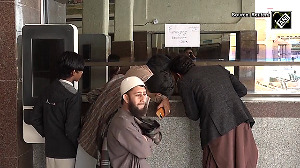Tom Friedman has got his challenger. The world is not flat, says the World Bank, in its latest World Development Report.
And don't you believe in the "death of distance", because distance from a centre of economic activity is a critical factor for both people and geographies.
Indeed the report, titled "Reshaping economic geography", argues that development is almost always concentrated -- and that is the way it is meant to be. So governments should be encouraging such concentration by facilitating migration and building the infrastructure that helps the process (like transport linkages).
It cites Tokyo-Yokohama's dominance of the Japanese economy and Cairo's in Egypt to make the point, though the Report does not seem to argue a 'cause and effect' sequence that goes beyond merely recording a fact that is obvious.
And yet, readers will immediately recall the success of China's coastal strategy, which was deliberately designed to encourage concentration of economic activity, and worked--one of the thoughts behind India's official support to special economic zones.
The report challenges some long-established notions, especially in India where the spatial distribution of industrial activity has been part of official policy for more than half a century.
There is the effort to "provide urban facilities in rural areas" (or Pura); there is Narendra Modi with his notion of a "rurban" (rural-urban) model for Gujarat; and variations on these themes.
The report does not necessarily disagree with such initiatives, arguing that policies should encourage inclusive growth and try to equalise standards of living across geographies. But that would seem counter-intuitive when it argues at the same time that uneven development is an inescapable fact of life.
The report is likely to provoke debate, and its authors say that it is meant to be a starting point for discussion, not a final argument.
Certainly, India has seen that the cluster logic works for many industries (Tamil Nadu as an auto hub, Bangalore as an IT-driven city, and one-industry towns that dot the country like Moradabad and Tirupur).
More importantly, the country needs to figure out how to make its cities work better (the correct pricing of land and the development of mass transport are crucial, and on both points realisation is only slowly dawning on politicians and policymakers), how to finance urban development in a self-sustaining manner, and how to make the divisions between rich and poor more porous within a city so that habitations do not become completely stratified.
But there will also be debate about the changing nature of the city (de-industrialised, and service-driven), the drift to suburbia, the move to off-centre, campus-style office complexes, and what each of these means for concentration.
As with all World Development Reports, there is a set of tables that provide inter-country comparisons on some basic parameters.
India now figures about two-thirds of the way down the list of about 130 countries when it comes to per capita income (it used to be 16th from the bottom when the WDR first came out three decades ago, but there were fewer countries then), and just about scrapes into the category of 'lower-middle income' countries with per capita income of $950 (for 2007).
In total economic size, it is the smallest among the Bric economies, being fractionally behind Russia and Brazil. It therefore ranks 12th as an economy, 25th as an exporter, 20th as a recipient of foreign investment, and gets one dollar per capita as official aid (lower-middle income country average: $9). It has the fifth highest external debt, but that debt is just 15 per cent of GDP (low- and middle-income country average: 75 per cent).
And the maximum numbers of out-migrants in the world are from Mexico, China and India, followed in short order by Iran, Pakistan and Indonesia. On most millennium development goals, India is better than the low-income country average, but worse than the typical lower-middle income country figure.
And in case anyone is still in the mood for chest-thumping, India's per capita income is about one-eighth of the world average.







 © 2025
© 2025